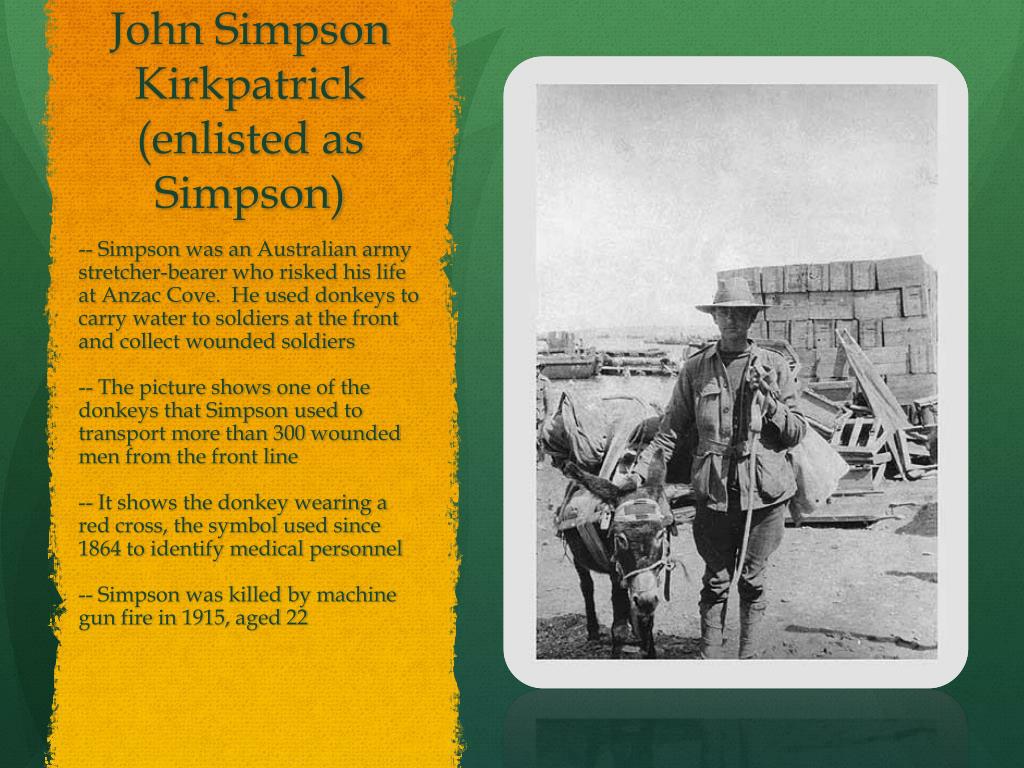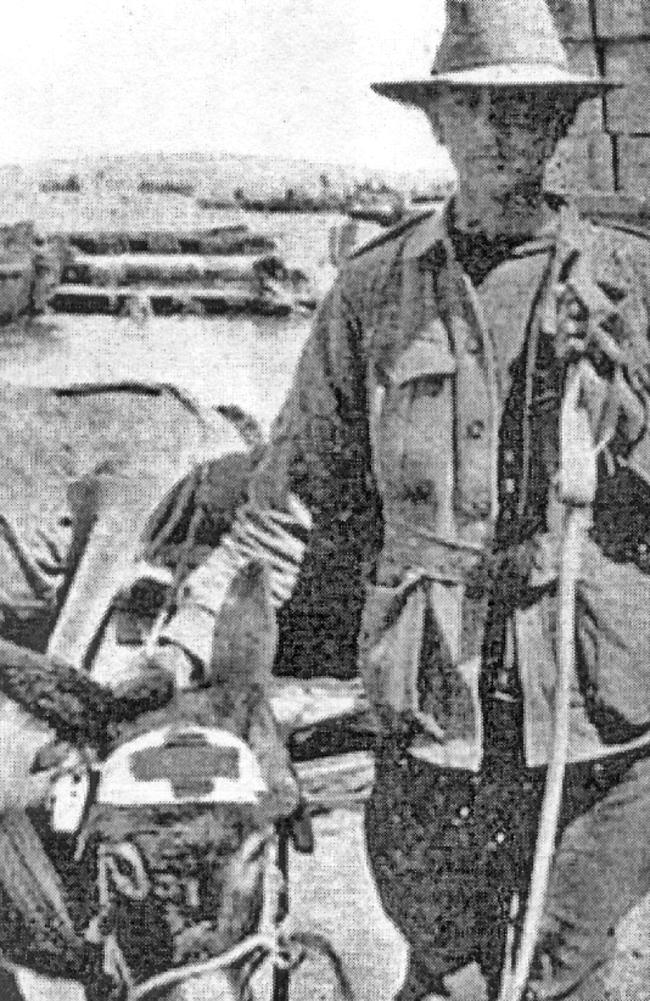Could the actions of a single individual truly shift the course of history and etch themselves into the annals of legend? The story of John Simpson Kirkpatrick, the man with the donkey, is a resounding testament to the enduring power of courage, compassion, and resourcefulness in the face of unimaginable adversity.
Amongst the brutal realities of the First World War, amidst the chaos of the Gallipoli campaign, a single figure emerged, transforming into a symbol of selflessness and bravery. John Simpson Kirkpatrick, known to many as "Simpson," wasn't just another soldier; he was a man who, against the backdrop of war's horrors, became a beacon of hope. Born in 1892 in South Shields, England, his life was one of humble beginnings. He later moved to Australia, and it was there, in August 1914, that he answered the call to serve, enlisting in the Australian Imperial Force. His journey, however, would take him to the shores of Gallipoli the following year as Private John Simpson of the 3rd Field Ambulance, Australian Army Medical Corps.
| Full Name: | John Simpson Kirkpatrick (Enlisted as John Simpson) |
| Born: | 1892, South Shields, England |
| Died: | May 19, 1915, Anzac Cove, Gallipoli |
| Nationality: | British (Born) / Australian (By residence and service) |
| Known For: | Stretcher bearer during the Gallipoli Campaign, using a donkey to transport wounded soldiers. Known as "the man with the donkey" |
| Military Service: | Australian Imperial Force, 3rd Field Ambulance, Australian Army Medical Corps |
| Rank: | Private |
| Key Actions: | Transported wounded soldiers from the battlefield to safety using a donkey, significantly increasing the number of lives saved. |
| Legacy: | Symbol of bravery, compassion, and ingenuity; subject of numerous books and memorials; an enduring figure in Australian and New Zealand war history. Awarded the Eve Pownall Book of the Year in 2009 for his story as a children's book. |
| Other Details: | Fair complexion, blue eyes, brown hair; Loved animals. |
| Reference: | Australian War Memorial |
The legend of Simpson, "the man with the donkey," took root amidst the carnage of the Gallipoli campaign. The Allied forces faced a brutal assault upon their landing at Anzac Cove on April 25, 1915. Many soldiers met their end before even reaching the shore. It was in this crucible of war that Simpson's acts of heroism would truly come to light. Instead of a glorious victory, Private Simpson found himself at Anzac Cove on April 25, 1915, and was killed less than four weeks later. He was sent with the allied forces to Gallipoli, where they were met with a brutal assault. Simpson, undeterred, recognized the urgent need to transport wounded men from the battlefield to safety. The conditions were appalling; manpower was stretched to its limits, and casualties mounted with alarming speed. Simpson, however, wasn't one to stand idly by. His ingenuity and compassion led him to a simple yet profound solution: a donkey. It was the war diary of the 3rd field ambulance that provided the earliest documentation of Simpson's actions.
The diary simply states that, from April 26th, John Simpson Kirkpatrick took a donkey up Monash Valley to carry slightly wounded cases, and has kept up his work from early morning till night every day since. This was not an easy undertaking. Simpson worked tirelessly to transport wounded men, and he did it independently, sometimes in disregard of orders, and.
The exact number of lives saved by Simpson remains a subject of debate. While some claims, such as the rescue of 300 men in three weeks, are considered to be of dubious provenance, the impact of his actions is undeniable. The war diary of the 3rd Field Ambulance provides a more grounded perspective. It notes that from April 26th, Simpson began using a donkey to carry wounded soldiers from Monash Valley, continuing his work "from early morning till night every day." He was famous for using a donkey to aid him as casualties grew and manpower was at its limits. This innovative approach not only increased the number of men he could assist but also brought a measure of hope to a desperate situation. The iconic figure of "Simpson and his donkey" looks towards War Memorial Drive from the Angas Garden.
The use of a donkey wasn't merely practical; it became a symbol. It offered a respite from the chaos. These pages are a seed for any burgeoning historian. The image of Simpson, with his gentle nature and unwavering commitment, became a source of inspiration for many. This courageous act and dedication to the wounded quickly turned him into a legend. John Simpson, otherwise known as the 'man with the donkey', was a stretcher bearer in the First World War. The best known of the bearers was John Simpson Kirkpatrick.
Simpson's bravery transcended the battlefield. He wasn't just any soldier; he was a man who would transform into a symbol of courage and compassion amidst the horrors of conflict. His story is well-known in Australian history. However, our understanding of Simpson as a war hero has persisted due to his ingenuity, courage, and selflessness. The Tyneside stretcher bearer enlisted in the Australian army as 'Si. Over the years there have been a number of petitions for Jack Simpson to be awarded a Victoria Cross (VC). In July 1967 Australian leaders sent a petition to the British War Office, signed by Prime Minister Harold Holt, the Governor-General, the Chief of the General Staff, and other leaders on behalf of the Australian people, requesting that a posthumous Victoria Cross be awarded to Private John.
The story of John Simpson Kirkpatrick 'the man with the donkey at Gallipoi' is well known in Australia. John simpson kirkpatrick was a famous anzac, who worked as a stretcher bearer at gallipoli during the 1915 campaign. Based purely on verifiable facts, john simpson kirkpatrick and his donkey are far from an ideal hero for the anzac legend, however, his part in the anzac legend grew to have an impact far greater than that of his deeds during the great war. His complexion was fair with blue eyes and brown hair. He was a typical digger: He loved all kinds of animals. Simpson and his donkey were awarded the Eve Pownall Book of the Year by the Children's Book Council of Australia in 2009. Teaching children about John Simpson Kirkpatrick. You might want to explore John Simpson Kirkpatrick among other Australian war heroes, to provide context for his work alongside the efforts of other soldiers. The purple cross medal is awarded for "exceptional work in the saving of human life" by the world society for the protection of animals.
Simpson's brief but impactful time at Gallipoli ended tragically on May 19, 1915, just three and a half weeks after landing at Anzac Cove. His death, like his life, was a testament to the horrors of war, but his actions during his short time on the frontlines have resonated for over a century. Simpson's memory has been immortalized in numerous ways. He is known as the man with the donkey for his ingenuity in recruiting a donkey he came across to help carry injured men to safety, thereby increasing the amount of men he was able to save.
The legacy of "the man with the donkey" endures. The story has been told and retold through countless books and memorials, solidifying his place in the Australian and New Zealand collective memory. He is seen as a symbol of Anzac spirit, embodying courage, compassion, and ingenuity in the face of adversity. Walsh this article was published in Australian dictionary of biography, volume 9, (mup), 1983. Simpson, as he was known, was at the landing at Gallipoli on 25 April 1915 and was killed on 19 May 1915.
Over the years, there have been numerous petitions for John Simpson to be posthumously awarded the Victoria Cross, the highest award for valor in the face of the enemy. While he never received the official recognition, his story has already secured its place as a symbol of heroism. In July 1967, Australian leaders sent a petition to the British War Office, signed by Prime Minister Harold Holt and other leaders, requesting a posthumous Victoria Cross for Simpson. Although this request was not granted, it reflects the high regard in which he was held and the lasting impact of his actions. He did this work independently, sometimes in disregard of orders, and.
The enduring power of his story lies in its simplicity: a man, a donkey, and a commitment to saving lives. It speaks to the capacity for human kindness and resilience, even in the darkest of times. John Simpson Kirkpatrick's story is a reminder that even in the midst of war, acts of compassion can endure, leaving an indelible mark on history. John H Pearn, MD, PhD, FRACP, Surgeon General Australia. These pages are a seed for any burgeoning historian.


